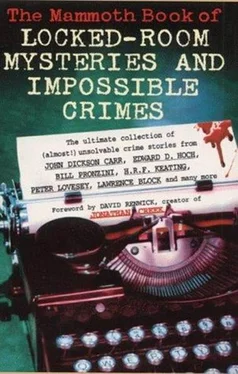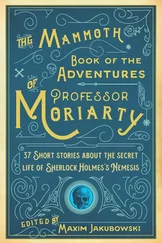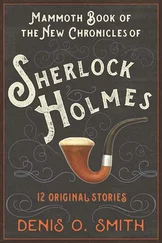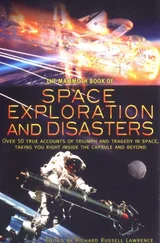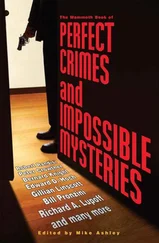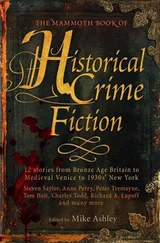Mike Ashley - The Mammoth Book of Locked-Room Mysteries And Impossible Crimes
Здесь есть возможность читать онлайн «Mike Ashley - The Mammoth Book of Locked-Room Mysteries And Impossible Crimes» весь текст электронной книги совершенно бесплатно (целиком полную версию без сокращений). В некоторых случаях можно слушать аудио, скачать через торрент в формате fb2 и присутствует краткое содержание. Жанр: Детектив, на английском языке. Описание произведения, (предисловие) а так же отзывы посетителей доступны на портале библиотеки ЛибКат.
- Название:The Mammoth Book of Locked-Room Mysteries And Impossible Crimes
- Автор:
- Жанр:
- Год:неизвестен
- ISBN:нет данных
- Рейтинг книги:3 / 5. Голосов: 1
-
Избранное:Добавить в избранное
- Отзывы:
-
Ваша оценка:
- 60
- 1
- 2
- 3
- 4
- 5
The Mammoth Book of Locked-Room Mysteries And Impossible Crimes: краткое содержание, описание и аннотация
Предлагаем к чтению аннотацию, описание, краткое содержание или предисловие (зависит от того, что написал сам автор книги «The Mammoth Book of Locked-Room Mysteries And Impossible Crimes»). Если вы не нашли необходимую информацию о книге — напишите в комментариях, мы постараемся отыскать её.
A new anthology of twenty-nine short stories features an array of baffling locked-room mysteries by Michael Collins, Bill Pronzini, Susanna Gregory, H. R. F. Keating, Peter Lovesey, Kate Ellis, and Lawrence Block, among others.
The Mammoth Book of Locked-Room Mysteries And Impossible Crimes — читать онлайн бесплатно полную книгу (весь текст) целиком
Ниже представлен текст книги, разбитый по страницам. Система сохранения места последней прочитанной страницы, позволяет с удобством читать онлайн бесплатно книгу «The Mammoth Book of Locked-Room Mysteries And Impossible Crimes», без необходимости каждый раз заново искать на чём Вы остановились. Поставьте закладку, и сможете в любой момент перейти на страницу, на которой закончили чтение.
Интервал:
Закладка:

Mike Ashley, Martin Edwards, Kate Ellis, Margaret Frazer, John Dickson Carr, Michael Kurland, Edward D. Hoch, Lois H. Gresh, Robert Weinberg, Lynne Wood Block, Lawrence Block, Michael Collins, Clayton Rawson, Amy Myers, Thomas Bailey Aldrich, Melville Davisson Post, C. N. Williamson, A. M. Williamson, Jacques Futrelle, Peter Tremayne, Bill Pronzini, Marilyn Todd, William Brittain, H. R. F. Keating, Peter T. Garratt, Richard A. Lupoff, Susanna Gregory, Howel Evans, Frank M. Robinson, Edward Marston, Peter Lovesey
The Mammoth Book of Locked-Room Mysteries And Impossible Crimes
A book in the The Mammoth Book of… series, 2000
FOREWORD by David Renwick
Life for Alvy Singer in Annie Hall can be divided into two categories, the horrible and the miserable. I would add a third: the unbearably tedious. Reality, when it’s not simply hideous or depressing, tends to be largely unremarkable – or in other words, real. And if, like Sherlock Holmes and me, you “abhor the dull routine of existence”, then books and television shows whose mission is accurately to reflect the world around us will leave you feeling either suicidal or bored witless.
Of course there is a place in detective fiction for the gritty social document, but it’s not a place I’d want to go to for a holiday. Personally I like my dramas to be a little improbable and my comedies a little absurd. I like, I suppose, to be taken to the edge: to teeter on the brink of plausibility, where logic lives dangerously yet somehow still manages to survive. For me this is where storytelling becomes exciting: when the writer is prepared to take risks; to bend the limits of invention. And if for Holmes there was respite from the routine in the form of a seven-per-cent solution perhaps the rest of us can at least find solace in a good locked-room mystery.
Although the impossible crime genre has long been well respected in the world of publishing few people in recent times have been so foolish as to try and make it work on television. This is because we are all so highly sophisticated now that heaven forbid a detective series should be fun. But in the certain knowledge that Jonathan Creek would be branded “preposterous” and “far-fetched” I was cheerfully prepared to have a go, with the quiet conviction that people, not plots, are the key to an audience’s acceptance. Providing the characters are real and respond truthfully to whatever you throw at them it is my view that you can take as many liberties with the storylines as you like. (Thus Victor Meldrew’s “I don’t believe it” in One Foot in the Grave is an honest reflection of our own incredulity at the bizarre twists of fate to which he is so often subjected.) Then, as Gideon Fell declares in John Dickson Carr’s The Three Coffins , “the whole test is, can the thing be done? If so, the question of whether it would be done does not enter into it.” Or as Creek himself points out in Jack in the Box , “We mustn’t confuse what’s impossible with what’s implausible. Most of the stuff I cook up for a living relies upon systems that are highly implausible. That’s what makes it so difficult to solve. No one ever thinks you’d go to that much trouble to fool your audience.”
Of course the problem, as Carr also observed, is that when the effect of a particular crime is magical we expect the cause to be magical also. And when the explanation for our baffling scenario turns out – as it must – to be more prosaic than the events leading up to it we may emerge from the experience feeling cheated. Even the most famous detective story ever written cannot escape this charge: did anyone ever learn that the Hound of the Baskervilles was “bought in London from Ross and Mangles, the dealers in Fulham Road” without a sense of anti-climax? Yet the novel is rightly celebrated because it performs what I believe to be the essential task of any creative work: it pushes the buttons. Within its pages I can think of at least half a dozen classic moments that never fail to send a thrill down the spine; moments that consume and intrigue, that defy you to put the book down. At its very least the “supernatural” mystery has a magnetic power over and above the conventional detective story: when someone appears to have violated the laws of nature we cannot but yearn to know how it was done. At its best it delivers a chillingly clever solution that reverses our whole perspective on events and sends us away with a warm and satisfying glow. When this happens – Carter Dickson’s The Judas Window , Jacques Futrelle’s The Problem of Cell 13 , Melville Davisson Post’s The Doomdorf Mystery – then you have a rare treat indeed.
All of which is to argue that a fascination for the impossible crime represents, in all of us, no more or less than a primal thirst for escapism. Like the spectral assailant who has miraculously vanished from the scene of the crime it’s comforting occasionally to give reality the slip and retreat into the more fantastical world of our imagination.
Introduction HEY, PRESTO! By Mike Ashley
The impossible-crime story is like a good trick. In fact it has to be better than a good trick. Not only must the puzzle fascinate and mystify, but the solution must be just as surprising, yet believable. How often have you had a magician’s trick explained and then felt deflated? It almost feels a cheat. Well, these stories had to avoid that. When you read the solution to the crime, you should be able to say, “That was clever. I’d never have thought of that.”
That’s what I hope we’ve done in this book. I’ve endeavoured to bring together a collection of stories that seem utterly baffling and where the solution is equally amazing. Not an easy trick.
Yet despite the impossible crime being such a difficult story to write, it remains at the core of the mystery story. These stories are as much “howdunits” as “whodunits”. They’re puzzles. They challenge the reader to try and solve the method before the author reveals all.
The whole point about an impossible crime is that when first discovered it must seem as if there was no possible way that the crime could have been committed. The most common approach is the locked-room mystery. In these the victim is found murdered in a room locked from the inside. He’s usually alone, and there is no other way into or out of the room. To make it even more fun he may have been shot or stabbed, but there is no murder weapon. There are endless variations on the theme. Other impossible scenarios are bodies found in the snow but with no other footprints beyond his own; property stolen from within a locked safe or room under constant watch; people or things disappearing in full view of an audience. The Golden Rule is that the solution to these crimes must be rational – there should be nothing supernatural or beyond current knowledge and understanding.
You’ll have seen a number of these ideas in David Renwick’s excellent Jonathan Creek television series, and I’m delighted that Mr Renwick has written a special foreword for this book.
You’ll find all these ideas and more in this anthology. What I looked for was originality, ingenuity, and a story that did not disappoint. I hope it lives up to both my and your expectations.
For those interested in discovering more about locked-room mysteries and impossible crimes I have provided a capsuled history as an Afterword.
Now, prepare to be baffled.
WAITING FOR GODSTOW by Martin Edwards
Интервал:
Закладка:
Похожие книги на «The Mammoth Book of Locked-Room Mysteries And Impossible Crimes»
Представляем Вашему вниманию похожие книги на «The Mammoth Book of Locked-Room Mysteries And Impossible Crimes» списком для выбора. Мы отобрали схожую по названию и смыслу литературу в надежде предоставить читателям больше вариантов отыскать новые, интересные, ещё непрочитанные произведения.
Обсуждение, отзывы о книге «The Mammoth Book of Locked-Room Mysteries And Impossible Crimes» и просто собственные мнения читателей. Оставьте ваши комментарии, напишите, что Вы думаете о произведении, его смысле или главных героях. Укажите что конкретно понравилось, а что нет, и почему Вы так считаете.
